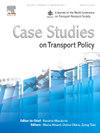Leveraging machine learning to predict Rural-Urban carpooling decisions given monetary incentives
IF 2.4
Q3 TRANSPORTATION
引用次数: 0
Abstract
This study pioneers a quantitative method for determining the monetary incentives needed to promote carpooling in an area. Utilizing travel behavior survey data from a rural county in Central Pennsylvania, we employed a Random Forest machine learning model to predict individuals’ carpooling decisions under different incentive scenarios based on their sociodemographic characteristics and existing travel behaviors. We then calculated the pivotal incentive amount that encourages an individual to switch from solo driving to carpooling and estimated the total incentive budget required to boost carpooling participation in an area to a certain desired level. Our analysis revealed that high spending on incentives does not necessarily result in proportional increases in carpooling participation. For instance, for our study area, the effective monthly incentive amount was capped at approximately $300. We also found that there are individuals who will not carpool at all, regardless of the incentive amount offered. Additionally, by clustering respondents based on their sociodemographic and commuting characteristics, we investigated how different groups of population respond to incentives. The results showed that younger adults, solo workers in a household, and those who commute longer and more frequently required the highest incentive amounts to switch to carpooling, whereas seniors and those with less frequent or shorter commutes could be swayed with incentive amounts about half as much. Such findings highlighted the importance of targeted strategies with detailed behavioral analysis when determining and allocating incentive funds. Finally, high performance metric values for the model demonstrated the potential of machine learning as a viable forecasting tool for similar transportation studies.
利用机器学习来预测在货币激励下城乡拼车的决策
本研究开创了一种定量方法,用于确定在某一地区推广拼车所需的货币激励措施。利用宾夕法尼亚州中部一个农村县的出行行为调查数据,我们采用随机森林机器学习模型,根据个人的社会人口特征和现有出行行为,预测他们在不同激励方案下的拼车决定。然后,我们计算了鼓励个人从单人驾驶转向拼车的关键激励金额,并估算了将一个地区的拼车参与率提高到一定预期水平所需的激励预算总额。我们的分析表明,高额的激励措施并不一定会使拼车参与率成比例地提高。例如,在我们的研究地区,每月的有效奖励金额上限约为 300 美元。我们还发现,有些人根本不会拼车,无论提供多少奖励。此外,我们还根据受访者的社会人口和通勤特征对其进行了分组,从而调查了不同人群对激励措施的反应。结果表明,年轻人、家庭中的单干者以及通勤时间较长、通勤频率较高的人群需要最高的激励金额才能转向拼车,而老年人和通勤频率较低、通勤时间较短的人群则只需要一半左右的激励金额就能说服他们。这些发现强调了在确定和分配激励资金时,有针对性的战略和详细的行为分析的重要性。最后,该模型的高性能指标值证明了机器学习作为一种可行的预测工具在类似交通研究中的潜力。
本文章由计算机程序翻译,如有差异,请以英文原文为准。
求助全文
约1分钟内获得全文
求助全文

 求助内容:
求助内容: 应助结果提醒方式:
应助结果提醒方式:


